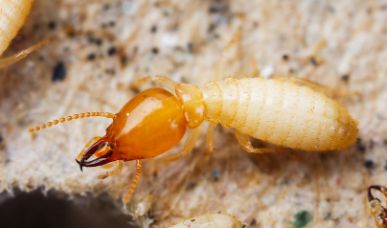Drywood Termites
What to Know About Drywood Termites in Central Florida
If you live in Central Florida, you will probably need termite services at some point. On this page, we’ll talk about drywood termites (Cryptotermes spp. and Incisitermes spp.). We, at Total Pest Services, will give you more detailed information on how to identify and cope with this species

Identification Factors
As you might know, termites can develop into one of 3 different role types: workers, soldiers, and reproductive termites. We will focus on soldiers and reproductive termites as the workers of all species look almost the same
#1. Size & Overall Appearance
Swarmers (or reproductive termites) can grow up to a ½ inch in length, while the soldiers are typically ⅜ inch long. Drywood soldiers have a large mandible with teeth, and their pronotum is wider than the head. Most of them are larger than the subterranean termites.
#2. Color & Distinctive Features
Drywood termites are usually pale brown although some of them can be dark and light brown, as well as any shade in between, with a yellowish tan. Alates (reproductive termites, swarmers) have wings that can be clear or smoky gray in color.
#3. Behavior, Diet, Habits
Drywood termites create colonies in wood (as their name suggests) and sometimes feed on other cellulose materials. They prefer warm tropical climates and are often found in attic wood where there is very little moisture.
When do drywood termites swarm in Florida?
The warm climate in Florida attracts not only tourists but also termites. Unlike other species, drywood termites can swarm any time of the year, but they are most active in the heat of the summer. If you are wondering what the best time is for a professional termite inspection, midsummer would be a correct guess.
Signs of Infestation
If you are doing the inspection yourself, you should pay closer attention to any dry wood structures such as foundations, window and door frames, furniture, and especially antiques. The most obvious signs you need a termite treatment are:
- Clicking noises – It’s hard not to notice when the workers are eating your wood, but one thing that you can’t miss for sure is when the soldiers are banging their heads against the wood to alert the colony to danger.
- Flying termites – While the workers and soldiers are loud and the clicking noises are obvious signs that you need termite treatment, spotting flying termites means that the colony will expand. The flying termites are actually the reproductive ones, and their only purpose is to establish more colonies.
- Hollow wood – Wood that has been eaten from the inside is another good sign you have an infestation.
- Surface blisters – Another extensive infestation indication is surface blisters resulting from termites tunneling near this surface.
The Solution
Infestations are not necessarily limited to one area and can be widespread. Also, keeping termites away from your home is not a one-time job but an ongoing process. We, at Total Pest Services, provide a yearly renewable drywood termite treatment bond. Get in touch with us for more details!
